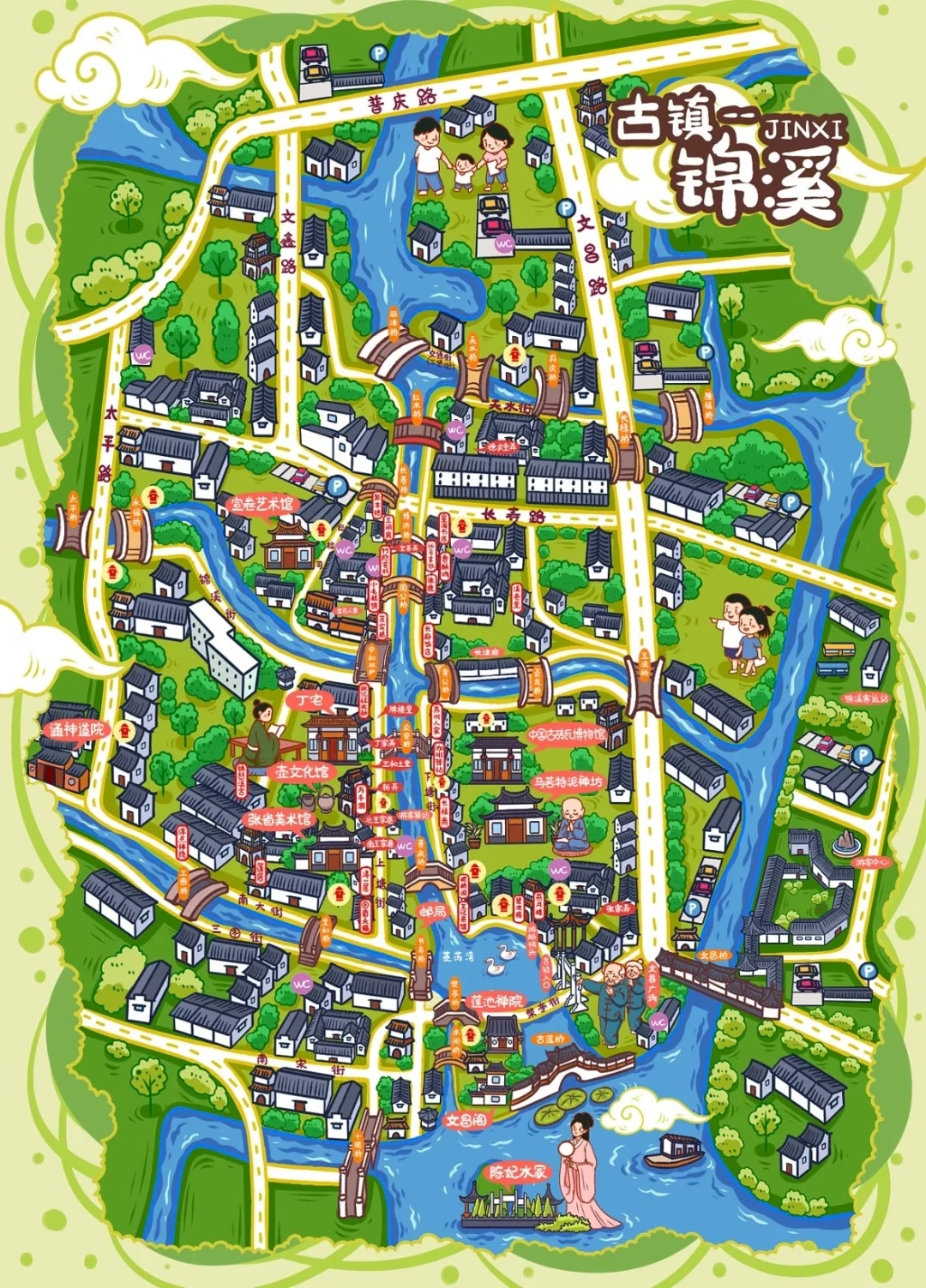Nestled in the heart of Kunshan, Suzhou, Jinxi Ancient Town (锦溪古镇) boasts a history spanning over two thousand years. Revered as the “Hometown of China’s Folk Museum,” this charming town preserves numerous cultural landscapes, historical sites, and distinctive architecture with a rich blend of Ming, Qing, and Republican styles.
The town is crisscrossed with a network of lakes and waterways, creating a picturesque scene. To the south lies the Five-Bao Lake and Dianshan Lake, while Chen Lake graces the northwest. The internal waterways of the ancient town extend up to 6 kilometers, forming a typical Jiangnan water town ambiance – connecting rivers and lakes, surrounded by marshes, streets and alleys hugging the water, and bridges linking pathways. Most of the existing residences in Jinxi were constructed during the Ming, Qing, and Republican periods. These homes, predominantly built along the water’s edge, are characterized by one to two-story brick and wooden structures, adorned with blue-tiled walls. Many open their doors and windows to the water or have waterfront docks.
Table of Contents
- Basic Information
- Location and Transportation
- Map of Jinxi Water Town
- Highlights of Jinxi Water Town
- Vlog about Jinxi Ancient Town
- A Brief History of Jinxi Ancient Town
- Useful Tips Summarized from Reviews
- Other Attractions in Kunshan
Basic Information
| Website | http://www.chinajinxi.com.cn/ |
| Estimated Length of Tour | 3 – 4 hours |
| Ticket Price | The town is free. The combined ticket for all the attractions costs 45 RMB |
| Attraction Opening Hours | 8.00 – 17.00 (1st April – 31st October) 8.00 – 16.30 (1st November – 31st March the next year) |
| Telephone Number | 0086-400-621-2855 |
Location and Transportation
Jinxi Ancient Town is nestled within the picturesque landscape of Kunshan, a city situated in the southeastern part of Jiangsu Province, China. This historical gem is strategically located approximately 60 kilometers (37 miles) west of Shanghai, one of China’s most vibrant and cosmopolitan cities.
Tourists from other cities can first take a high-speed train to Kunshan South Railway Station and then transfer to bus 133 or a taxi to cover the remaining 25 kilometers.
Map of Jinxi Water Town

Highlights of Jinxi Water Town
Chen Concubine Water Tomb

Located in the southern Five-Bao Lake of Jinxi Town, Chenfei Shuizong (Chen Concubine Water Tomb) tells a poignant story. In the first year of the Longxing era (1163), during the Jin invasion, Emperor Xiaozong moved south to Lin’an with his entourage. Along the way, Chen Concubine fell ill and passed away, prompting the construction of a water tomb. Regardless of water level fluctuations, the tomb consistently surfaces on the lake, creating a scenic marvel. After extensive restoration in 1992, it was declared a cultural heritage site in 1997, marking its significance in Kunshan City.
Charming Waterways and Stone Bridges

Jinxi Ancient Town is adorned with elegant bridges due to its intricate water network. Tianshui Bridge, commonly known as North Guanyin Bridge, was initially constructed in 1407, financed by Guo Zijing. It was rebuilt in 1652, with a length of 17.2 meters and a width of 2.7 meters, made primarily of granite with a blue stone arch. Puqing Bridge, also known as Yu Family Bridge, was built in 1733, spanning 18.5 meters in length and 2.8 meters in width, maintaining its original integrity. Shiyu Bridge stretches from Funtang Port to Wubao Lake, measuring 52 meters in length, 2.8 meters in width, and 3 meters in height, featuring nine piers and ten arches constructed with neatly stacked stones. After various renovations, these bridges are well-preserved today.
Artisanal Workshops

Jinxi Ancient Town’s artisanal workshops offer a captivating window into traditional craftsmanship. Delve into the world of skilled artisans as they meticulously create intricate wonders, from delicate embroidery and intricate paper-cutting to pottery and woodwork. These workshops are living embodiments of China’s cultural heritage, where techniques passed down through generations come to life. Visitors can engage with craftsmen, witnessing their dedication and passion firsthand. Through hands-on experiences and observation, one can grasp the essence of these time-honored arts, fostering a deep appreciation for the artistry and skill that have thrived in Jinxi for centuries.
Ancient Temples

Temples grace Jinxi Ancient Town, each bearing its own historical significance. Tongshen Taoist Temple, originally named Tianqing Temple, dates back to the Southern Song Dynasty, with expansions during the Yuan, Ming, and Qing dynasties. It features the East Yue Hall and the mountain gate, covering an area of 200 square meters. Lianchi Zen Temple, founded in the Southern Song Dynasty, occupies an expansive 5111 square meters. Wenchang Pavilion, built in the Ming Dynasty, is a three-story pavilion-style structure with brick and wooden framework, flying eaves, and a height of 15.6 meters, covering an area of approximately 200 square meters.
Cultural Museums

Jinxi Ancient Town is also home to a collection of museums, including the Yixing Purple Clay Museum, showcasing exquisite purple clay pottery from the pottery capital Yixing; the Ancient Brick and Tile Museum, featuring over 2300 items, including roof tiles, drip edges, roof ridge components, building bricks, inscribed bricks, and sacrificial bricks; and an Antique Museum established by the Suzhou antique collector Mr. Xue Rensheng. The museum’s exhibits cover a wide range, distributed across three floors, with lacquerware, wood carvings, Ming and Qing furniture displayed on the ground floor, ceramics, calligraphy, and jade artifacts on the second floor, and a collection of 800 water basins, pen holders, brush washers, and brush racks spanning 3000 years on the third floor.
Vlog about Jinxi Ancient Town
A Brief History of Jinxi Ancient Town
Jinxi Ancient Town, located in Zhejiang Province, has a history that dates back over 5,500 years to the Songze culture period. During the Spring and Autumn period of the Wu-Yue kingdom, it became a settlement and was part of the Kuaiji Commandery. From the Three Kingdoms to the Tang Dynasty, it was part of Wu Commandery, and during the Five Dynasties, it belonged to Suzhou.
In the first year of the Song Dynasty’s Shaoxing reign (1131), the town was administratively divided along the North and South Market Rivers, with areas on the west side of the river placed under Changzhou County and those on the east side under Kunshan County. In September 1952, parts of Wu County, including towns like Chenmu, Zhouzhuang, and others, were incorporated into Kunshan County. The two counties’ Chenmu town merged and was upgraded to a sub-county town of Kunshan.
In 1985, the town administration system was reformed, merging villages into Chenmu Town, which was renamed Jinxi Town in 1992. The town began its tourism development in 1995 and was recognized as a 4A National Tourist Attraction in 2005. T
Useful Tips Summarized from Reviews
Recommended Local Delicacies:
- Haitang Cake: Try the sticky and chewy Haitang Cake with a delicate red bean filling.
- Radish Shredded Pancake: Highly praised for its delicious taste.
- Qingtuan: Enjoy this refreshing rice cake made with glutinous rice.
- Ao Zao Mian: Don’t miss the local noodles known as “Ao Zao Mian” in Kunshan.
Boat Ride Experience: Consider taking a boat ride for 150 yuan per boat, accommodating up to 6 people (children included), lasting approximately 25 minutes. The boat operator, often a local woman, may sing a local song in the native language. It’s customary to give a tip of around 30 yuan for this unique experience.
Explore the Town at a Leisurely Pace: Jinxi Ancient Town is not very large, and you can explore it in 2-4 hours. It offers a quaint atmosphere with a climate of early development as a tourist attraction. While not heavily commercialized, there are areas that are still undergoing improvement. Apart from the main route, there are many old and traditional houses. Note that the lack of clear signage may lead to taking the wrong path, so be cautious.






Jinxi Ancient Town is my favorite among many ancient towns I have visited. It is not overly commercialized, the scenery is beautiful, and it’s very relaxing. Those who appreciate a tranquil and ancient atmosphere should definitely take a stroll here. Nearby is the famous Zhuozheng Ancient Town, which is quite commercialized. If it’s your first time visiting an ancient town and you enjoy a lively atmosphere with plenty of shops, you might want to check it out. However, if you’re… Read more »
Jinxi Ancient Town does not have such a strong commercial atmosphere. The light drizzle made everything just right, and the scenery is filled with the charm of a southern water town. While wandering around and sampling the local food, I was amazed by the hawthorn cake sold by the roadside. The surface, made with red bean and osmanthus filling, is caramelized but not overly sweet. After placing my order, it was freshly made and served warm. Compared to the surrounding… Read more »
Jinxi ancient town is much less commercialized compared to Zhouzhuang and Tongli. The crowd is not large, and the prices are reasonable. The Brick Kiln Museum is quite interesting, with a lot of informative exhibits. The Ancient Lotus Bridge would probably look even more beautiful in the summer when the lotus flowers are in full bloom.
You can start your day from Shanghai and head to Jinxie Ancient Town in the morning. Have lunch in the ancient town, and then in the afternoon, visit the Dianshan Lake Half-Marathon Grassland to take some photos of the beautiful cosmos flowers and enjoy the sunset. The ancient town is not very large, so you can explore it quite quickly. Jinxie Ancient Town has retained much of its original charm, with a low level of commercialization, making it a nice… Read more »
Bibo Tower (碧波楼) is the best-located restaurant in the whole town, beautifully situated by the lake both day and night. However, the prices are a bit steep, roughly double that of the small eateries outside.
The ancient town is quite small, and one hour is enough to explore it. Some areas seemed to be under renovation, so the experience felt average. However, it’s free to wander around casually.
The greenery in Jinxian Ancient Town is exceptional, with lush trees providing ample shade everywhere you look. Visiting here in summer for a getaway is truly a delightful experience.
During the plum rain season in Jiangnan, the rain washes the lotus leaves in the pond clean and translucent, but unfortunately, there isn’t a single lotus flower in sight. All the flower buds seem to have disappeared!
As of this weekend, the lotus flowers in Jinxi Ancient Town have not fully bloomed yet. If you want to see the lotus flowers, you may need to wait a little longer.
Jinxi Ancient Town is located near Zhouzhuang Ancient Town and not far from Tongli Ancient Town. It is less commercialized compared to other popular ancient towns. There is not much crowding, and the leisurely pace makes people feel very comfortable. Jinxi is not large, and it can be explored in about 2 hours. After that, you can choose to visit Zhouzhuang or Tongli.